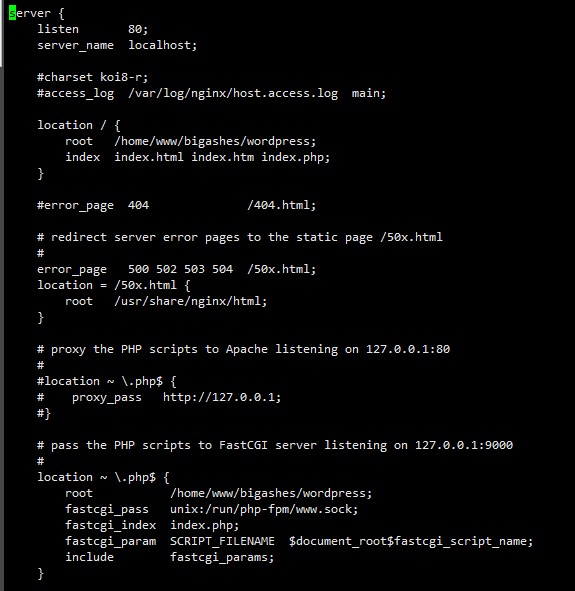搭建LNMP环境
准备环境
- 关闭防火墙
systemctl status firewalld #查看当前防火墙状态
systemctl stop firewalld #关闭当前防火墙
systemctl disable firewalld #永久关闭防火墙
更多内容请查看firewalld官网
- 关闭SELinux
getenforce #查看当前SELinux状态
setenforce 0 #临时关闭SELinux
更多内容请查看开启或关闭SELinux
安装Nginx
- 普通http 极速安装
本篇为普通安装,搭建HTTP网站 https 需要编译安装,详细看另一篇 Nginx编译安装
yum -y install nginx #安装nginx
nginx -v #查看版本,有列出信息则安装成功
安装Mysql
dnf -y install @mysql #安装mysql
mysql -V #查询版本,有列出信息则安装成功
安装PhP
dnf -y install epel-release
dnf update epel-release #添加并更新epel源
dnf clean all
dnf makecache #删除缓存无用的软件包并更新软件源
dnf module enable php:7.3 #启用php:7.3模块
dnf install php php-curl php-dom php-exif php-fileinfo php-fpm php-gd php-hash php-json php-mbstring php-mysqli php-openssl php-pcre php-xml libsodium #安装php相应的模块
php -v #查询版本,有列出信息则安装成功
配置环境
配置Nginx
cat /etc/nginx/nginx.conf # 查看Nginx配置文件路径
Centos安装的nginx配置文件一般默认为这个位置,Ubuntu下的位置为/var/nginx/sites-enabled/default
cd /etc/nginx/conf.d
cp default.conf default.conf.bak #备份默认配置文件
vim default.conf #vim编辑默认配置文件
在location /{ }括号内修改
location / {
#将该路径替换为您的网站根目录。
root /usr/share/nginx/html;
#添加默认首页信息index.php。
index index.html index.htm index.php;
}
修改php$,去掉注释
location ~ \.php$ {
root /usr/share/nginx/html; #将该路径替换为您的网站根目录。
fastcgi_pass unix:/run/php-fpm/www.sock;
fastcgi_index index.php;
fastcgi_param SCRIPT_FILENAME $document_root$fastcgi_script_name;
include fastcgi_params;:wq
}
fastcgi_pass:是Nginx通过unix套接字与PHP-FPM建立联系,该配置与/etc/php-fpm.d/www.conf文件内的listen配置一致。 fastcgi_param:将/scripts$fastcgi_script_name修改为$document_root$fastcgi_script_name。 include:Nginx调用fastcgi接口处理PHP请求。
编辑好后文件结构应该如下

systemctl start nginx #启动Nginx
systemctl enable nginx #开机启动Nginx
配置MySQL
systemctl enable --now mysqld
systemctl status mysqld
mysql_secure_installation
ubuntu下先查询 /etc/mysql/debian.cnf的默认密码
mysql -u debian-sys-maint -p # 换行后输入上述查到的密码
进入mysql
use mysql;
flush privileges;
ALTER USER 'root'@'localhost' IDENTIFIED WITH caching_sha2_password BY 'XXXXX'; #XXXX是密码
flush privileges;
quit;
service mysql restart
mysql -u root -p # 回车后输入自己修改后的密码即可
配置PHP
vi /etc/php-fpm.d/www.conf
vim /目录/phpinfo.php
测试访问
在网站的目录下新建一个php文件
vim info.php
<?php echo phpinfo(); ?> #这是文件中输入的内容
然后在浏览器中访问这个文件(域名/info.php)若出现配置信息则代表php-fpm和nginx正常通信